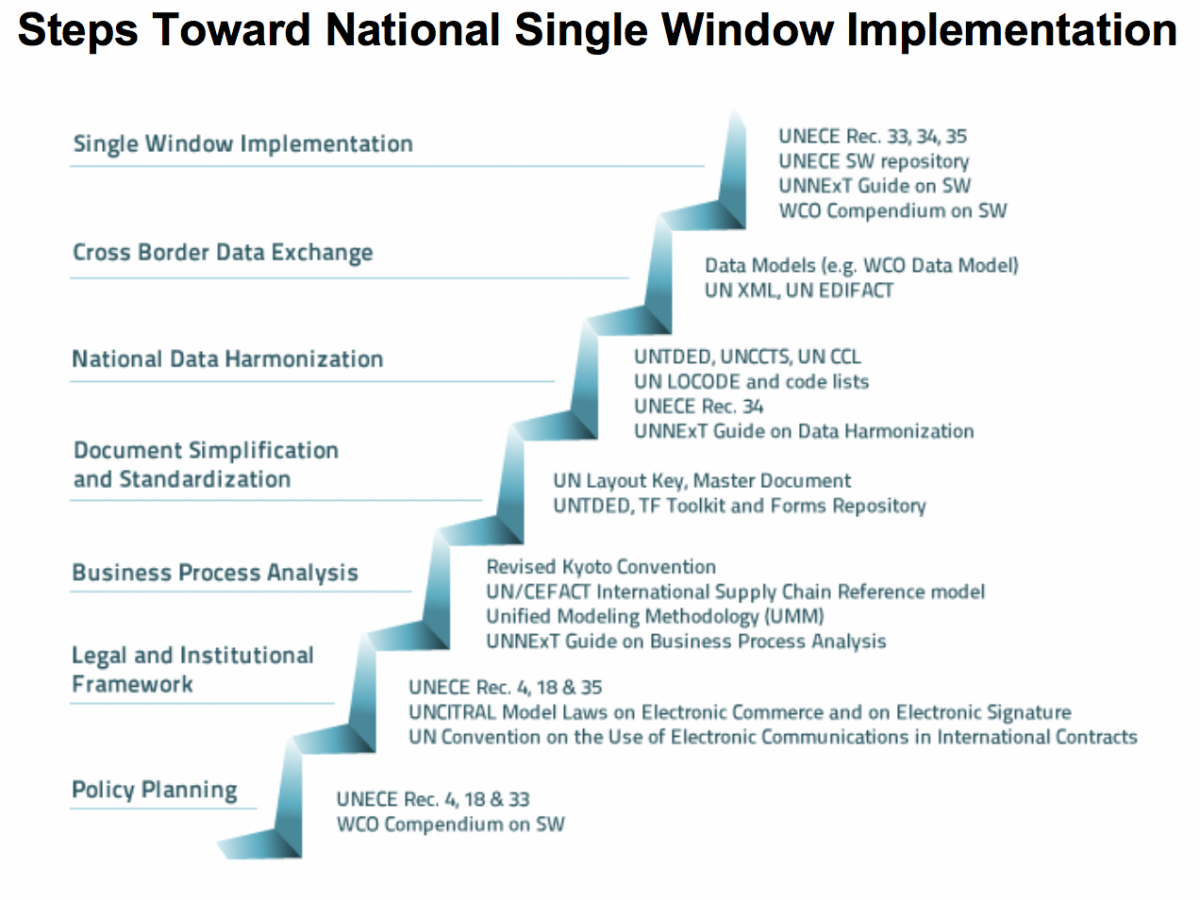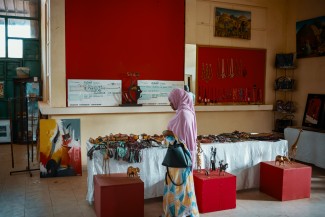|
|
|
Imagine you own a small manufacturing business in Colombia. Although your product is selling well in the domestic market, you have export sales orders from across South America, Europe and Asia. But, even fulfilling orders from neighbouring Brazil involves numerous rules, rates and a language barrier. You’ve also recently become aware of opportunities to import key components from international suppliers. Imported parts could yield lower total costs, yet they will complicate procurement processes and compliance with rules of origin when exporting final products. How would you conduct these cross-border transactions in the most efficient way for your business?
Trade is complex, time consuming and costly, as enterprises need to be aware of and comply with rules under different international agreements and legal systems. It has been estimated that an average customs transaction involves 30 parties, 40 documents and 200 data elements that form a ‘data supply chain’ along the value chain of any product. For micro-, small- and medium-sized enterprises (MSMEs), sourcing from or selling into international markets can be daunting and seem infeasible. Challenges are further amplified when small businesses are located in developing and least developed countries (LDCs).
[related-article]
The World Trade Organisation (WTO) has shown that data flows facilitate information sharing among entities in the trade logistics chain and lower the coordination costs of moving goods from conception to production to consumption. Improved access to data reduces information asymmetries and decreases transaction costs. Facing high costs of doing business and barriers to international markets, small enterprises in LDCs have the most to gain from better use of data for trade facilitation.
Computational forms of rules, through tabular programming methods, have the potential to accomplish the goals of trade facilitation: to simplify, modernise and harmonise import and export processes. As standards that facilitate coherent exchange of data across systems and jurisdictions are growing in adoption, an ‘Internet of Rules’ (IoR) could enable policy automation with separation of data, network and application control. In times of global and regional crises, the responsiveness of trade policy is critical for small business survival.
Designing ‘human-centred’ trade facilitation solutions: How does it work?
Traditionally, trade facilitation reform has not been sensitive to the realities of firm size and small businesses have become increasingly reliant on access to information via the internet. Further research from UNCTAD indicates that small enterprises benefit most significantly from ‘soft infrastructure’ for cross-border management via information and communications technology (ICT). Given this paradigm, novel collaborations are moving forward between governments, lawyers, academics, businesses, ‘legal hackers’, technology communities, chambers of commerce, international organisations and standards bodies to express regulations in computational form so that anyone can automate their application.
Over existing networks, ‘rules as data’ can be published by authorities or private entities and utilised by point of sale, transportation/ports, national single window systems and other platforms. Ultimately, connectivity that arises helps entities to disrupt administrative and expertise barriers to trade. Rule sets expressed, exchanged and applied in this manner lead to the materialisation of an Internet of Rules for universal accessibility of the rules/data relevant to any transaction.
For importers, exporters and intermediaries, compliance with rules across goods codes and jurisdictions becomes based on agnostic commercial data. By expressing computational rules and publishing them online, required data elements found in trade documents and the results of calculations (based on the rules) can be returned to authorities at the consent of buyers and sellers. This would help people to fulfill disparate paper-based and ‘digital document’/paperless environment compliance requirements while allowing for controlled and auditable payments.
[related-article]
A transparent and predictable Internet of Rules will modernise the experience of accessing information and engaging in international trade. Businesses and consumers would be able to quickly determine the total cost of goods, including tariffs/taxes. Governments could generate revenue in real-time and transportation/performance issues could be more precisely diagnosed. It’s also simple to author a rule in this form – an algorithm: it involves constructing ‘control tables’ in parallel to new and/or existing text versions of policies.
The benefits for goods trade are clear given Ptashkina and Cuiriak’s classification of digital-enabled modes of commerce with intermediaries (e.g. online marketplaces). These cross-border transactions involve ‘real-to-real’ contexts where the intermediate determination of rules (e.g. utilisation of tariff preferences) is important for buyers and sellers alike. In the ever-mixing physical-digital realms of the global trading system, compliance would be demystified while pure digital trade would be possible to regulate. Business rules in this form achieve ‘harmonisation’ in function and these enhancements reflect the aspirations of trade facilitation.
Institutions, technology and international standards: Who are the stakeholders?
The implementation of trade facilitation reform involves both public and private sectors. Public stakeholders include government agencies, officials, legislative drafters and policymakers. Private stakeholders are traders, transportation/service providers, banks, insurance companies, consumer groups and members of civil society.
Enhancing connectivity for international transport and delivery of goods requires addressing both existing and emergent constraints to the interface between markets. In providing a unique framework for partnerships to implement the WTO Trade Facilitation Agreement, National Trade Facilitation Committees (NTFCs) enable business-government consultation and public-public/international customs cooperation. All countries have the capacity to build human-centred solutions for trade facilitation, yet the development of an Internet of Rules for trade will require inclusion alongside policy initiatives. To overcome coordination obstacles, NTFCs can include a rules as data approach directly in national roadmaps to implement reforms.
Practically speaking, digitalisation relies heavily on standards to make data more useful and allow for interoperability. Companies around the world are beginning to obtain legal entity identifiers, the World Customs Organization (WCO) has specified a cross-border data model, and bodies of the United Nations (e.g. UNCITRAL, UN/CEFACT, and UNNExT) have created essential legal-technological frameworks. The UNCITRAL model laws have been co-drafted by numerous countries working to universally benefit from a shared legal template for a digitally enabled economy. These standards and legal structures have improved cross-border data exchange and the deployment of single window systems in countries around the world.

Source: UN/CEFACT
Additionally, utilising the Pan European Public Procurement On-line (Peppol) network, many European countries have adopted the Universal Business Language (UBL) (ISO/IEC 19845:2015) for cross-border electronic invoicing of government clients. Through an open ‘4-corner-model’ where buyers and suppliers use different access points, the Peppol approach has extended beyond Europe to include Australia, New Zealand and Singapore. The model allows for interoperability in many contexts: legal, organisational, semantic and technical. In North America, the US Federal Reserve Bank of Minneapolis is facilitating the specification of the Business Payments Coalition 4-corner-model network for use in the US, Canada and Mexico.
The OASIS-led Universal Business Language represents a free, common, library of standardised electronic business documents for digitisation of commercial/logistical processes in domestic and international supply chains. As a ‘lingua franca’, UBL’s common format empowers diverse entities to exchange information along supply chains. The current version of UBL features 89 different document types, many for procurement and transportation, including for customs and carnet.
Making it happen: Bringing new meaning to ‘trade networks’
We can go a step further to realise the full benefits of the digital transformation of trade. Given existing internet architecture, a ubiquitous system for authoring, publishing and distributing executable rules enables automation at scale. The development of an Internet of Rules is especially attractive for companies that offer data, trade compliance and global logistics automation services or for powering in-house development of single window platforms by national governments.
The capability of ‘forward-chaining’ – linking rules that refer to other published rule sets – allows for incorporation by reference and implies that the efforts of contributors in all countries can be mutually reinforcing. Stakeholder engagement between NTFCs and standards bodies, by means of structured participation in community / working groups or events like hackathons, can rapidly expand the body of rules published online.
New plurilateral arrangements for the digital economy and major legal decisions on international data transfers, such as the judgement issued by the Court of Justice of the European Union in the “Schrems II” case, illustrate that cross-border rules on data will become a simultaneous concern and opportunity for trade. For this reason, the shift toward paperless trade requires that all relevant experts collaborate more closely.
It will take cooperation to realise an internet-enabled market that is accessible to all. Working together, technology and policy spheres can move us toward a future where businesses, regardless of size or location, can participate in international trade. Akin to the early days of the World Wide Web, building an Internet of Rules will require diverse contributions.
Header image of Biruktawit Begashaw and the range of items she exports - ©Fernando Castro/EIF
If you would like to reuse any material published here, please let us know by sending an email to EIF Communications: eifcommunications@wto.org.



